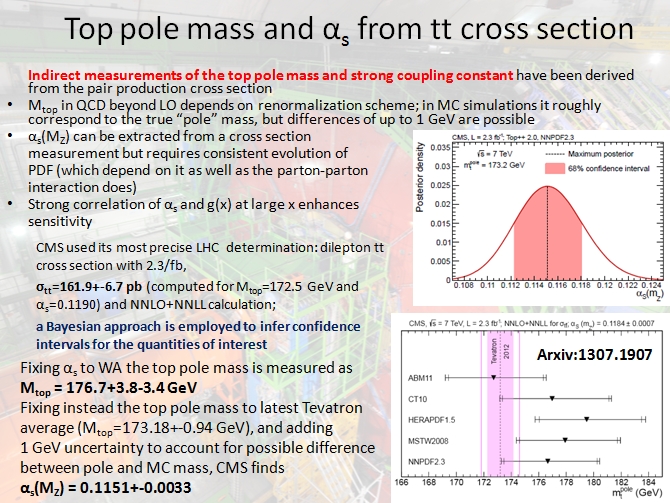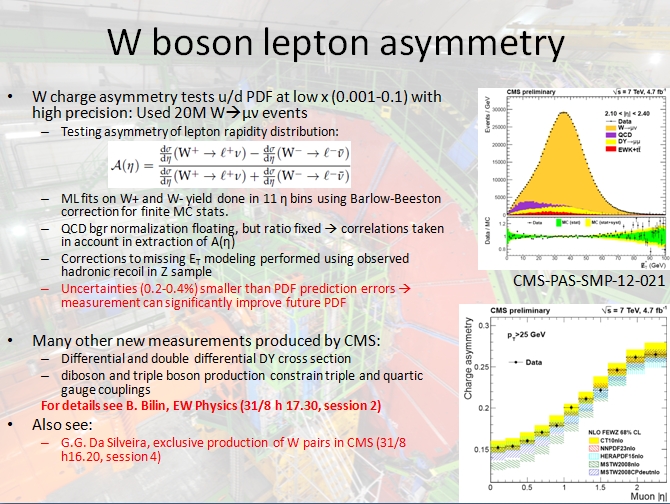Here I cannot replicate the whole talk (but you can access it here if you are curious), nor does it make sense to paste all my slides. I will just do so with selected few of them, which might be of some interest to you.
Let us begin with a combined measurement of top quark pole mass and strong coupling constant, performed by comparing with theoretical calculations the top quark pair production cross section measured by CMS very precisely with 7-TeV proton-proton collisions. The measurement was performed with "dilepton" events: events where both top quarks yield a lepton, a neutrino, and a b-quark when they decay. This final state is very clean and the CMS measurement stands as the single most precise determination of the production cross section at 7 TeV that we have available so far.
Since the cross section depends on the mass and the value of the strong coupling constant (a stronger coupling constant yields more top quarks, and a larger top mass yields fewer of them), the comparison may yield information on those two quantities - but not both together, since there is only one input (the measured cross section). However, what is interesting is that the strong coupling constant is known very precisely from other determinations, so one may derive the top quark mass cleanly. And this is not exactly the "top quark mass" which we usually measure by comparing reconstructed final state energies to what the simulations predict: the latter is slightly different because of a subtlety connected to renormalization.

The two graphs in the slide show the strong coupling constant measurement (the red gaussian-like curve shows the probability density as a function of alpha_s) for an assumed top mass of 173.2 GeV, and the top mass measurements (black dots with horizontal error bars) using the world average value of alpha_s, for different hypotheses of how partons behave inside protons (the so-called "parton distribution functions"). The pink vertical band shows the direct Tevatron measurements of the top mass, for a comparison.
The other thing I want to quickly mention here is the content of a slide on the section of my talk on electroweak precision measurements. This is the determination of the lepton asymmetry distribution obtained from W boson decays measured by CMS. An asymmetry in the angle of production of the charged lepton emitted in W decay (the angle is measured with respect to the beam line) is expected by the fact that the W is produced by the annihilation of a up quark in a proton and a anti-down antiquark in another proton, or by a anti-up quark with a down quark.
Since up quarks and down quarks do not carry the same fraction of the proton momentum, one expects that positively-charged leptons will behave differently from negatively-charged ones; in particular, the difference will be in their emission angle, which informs us on the relative momentum carried by the two initial state quarks which originated the W boson.
The lepton asymmetry (measured as a difference between the angle distribution of positive and negative leptons) thus tells us very precisely how different are the momentum fractions of up and down quarks in the proton. And CMS exploited a statistics never so far heard of to make this measurement as precise as possible: 20 million W bosons - a sample ten times larger than the next-largest one used for asymmetry determinations.
The result is a asymmetry function which challenges theoretical models for a precise interpretation. By fitting different models through the data the parton distribution functions may be made considerably more precise - and this will have a direct benefit in the precision of the measurements of the W boson mass, which remains one of the parameters of the Standard Model which we need to know with the highest precision nowadays.

In the slide you can see two graphs. The top one shows the distribution of observed missing transverse energy in the large sample of collected W boson decays. In orange there is the W contribution, other colours show the backgrounds. The bottom graph shows the measured asymemtry (black points) compared to predictions of different sets of parton distribution functions.
A bottomline from the above mentions of two CMS measurements is the following: in hadron-hadron collisions, everything depends on the parton distribution functions of quarks and gluons in the colliding projectiles - and many of the measurements are heavily affected by them. Turning a problem into an opportunity, the measurements can be used to understand the proton better than ever...



Comments